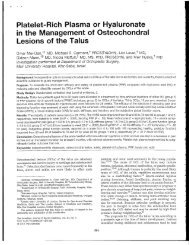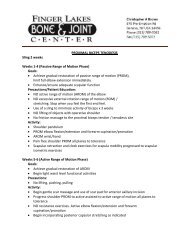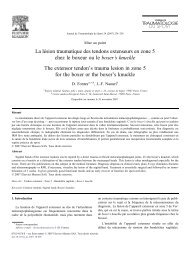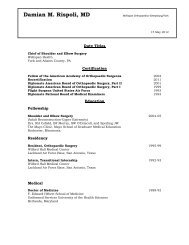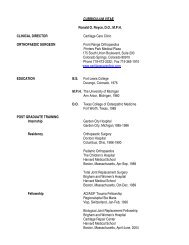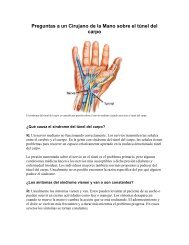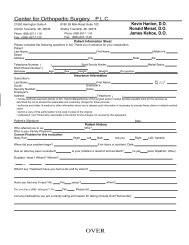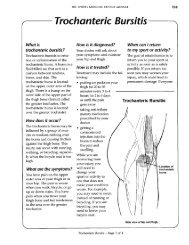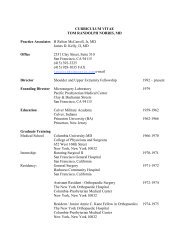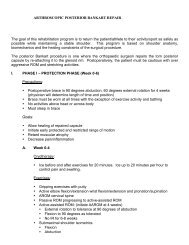Elbow - Arthroscopic Treatment of Elbow Stiffness - OrthoDoc@aaos ...
Elbow - Arthroscopic Treatment of Elbow Stiffness - OrthoDoc@aaos ...
Elbow - Arthroscopic Treatment of Elbow Stiffness - OrthoDoc@aaos ...
Create successful ePaper yourself
Turn your PDF publications into a flip-book with our unique Google optimized e-Paper software.
oscopic <strong>Treatment</strong> <strong>of</strong><br />
<strong>Stiffness</strong><br />
tJdadra. Matthew T Provenchel; Mark S. Cohen,<br />
A. Romeo
PITFALLS<br />
• Look for evidence <strong>of</strong> heterotopic<br />
ossification as the source <strong>of</strong><br />
elbow joint loss <strong>of</strong> motion.<br />
• Significant heterotopic<br />
ossification will preclude<br />
arthroscopic intervention for<br />
adequate return <strong>of</strong> function.<br />
• Procedure should not be<br />
considered unless the surgeon is<br />
highly skilled in elbow<br />
arthroscopy.<br />
Controversies<br />
• When to decompress the ulnar<br />
nerve<br />
• Indications for whether open or<br />
arthroscopic elbow release<br />
would be most appropriate<br />
Indications<br />
• Loss <strong>of</strong> elbow functional range <strong>of</strong> motion (ROM)<br />
prevents the patient from performing activities <strong>of</strong><br />
daily living and occupational or vocational activities,<br />
and failure <strong>of</strong> nonoperative treatment modalities<br />
Examination/Imaging<br />
PHYSICAL EXAMINATION<br />
• It is critical to determine the degree <strong>of</strong> functional<br />
impairment for each patient and base management<br />
decisions on subjective impairment, not necessarily<br />
the amount <strong>of</strong> motion loss (Jupiter et aI., 2003).<br />
• Obtain a history <strong>of</strong> associated conditions; ne ""Innil'.<br />
peripheral nerve, or brain injury may influence<br />
management decisions.<br />
• Determine function <strong>of</strong> the entire ipsilateral and<br />
contralateral upper extremity.<br />
• Determine hand dominance, occupation, and extrmtl<br />
<strong>of</strong> prior therapy, including bracing (both static and<br />
dynamic).<br />
• Evaluate the shoulder joint to ensure good strength<br />
and ROM .<br />
• Carefully assess nerve function .<br />
• Two-point discrimination<br />
• Assess all hand digits on radial and ulnar<br />
• Describe amount <strong>of</strong> discrimination (normal is<br />
• Document function <strong>of</strong> the FPL, median-anterior<br />
interosseous nerve, extensor pollicis longus, and<br />
radial-posterior interosseous nerves. Score with<br />
standard muscle resistance grade <strong>of</strong> 0 to 5.<br />
• It is important to document function<br />
preoperatively as elbow arthroscopic instruments<br />
work near these structures .<br />
• <strong>Elbow</strong> active and passive ROM<br />
• Place humerus at 90° and assess both active and<br />
passive flexion and extension with a goniometer.<br />
• Evaluate for s<strong>of</strong>t ("spongy") versus hard endpoints<br />
<strong>of</strong> flexion and extension. A s<strong>of</strong>t endpoint can<br />
indicate s<strong>of</strong>t tissue constraint; a hard endpoint may<br />
represent bony impingement.<br />
• Score ROM to provide baseline measurement:<br />
• Normal: 0-140°<br />
• Minimal impairment: >90°<br />
• Moderate impairment: 61-90°<br />
• Severe impairment: 31-61 °<br />
• Very severe impairment: total arc <strong>of</strong>
<strong>Treatment</strong> Options<br />
• Consider nonoperative<br />
management up to 4-6 months<br />
after contracture onset.<br />
• Static progressive splints, which<br />
allow for stress relaxation <strong>of</strong> the<br />
s<strong>of</strong>t tissues, are more effective<br />
and better tolerated than<br />
dynamic splints.<br />
• Results <strong>of</strong> arthroscopic elbow<br />
release and debridement have<br />
not differed significantly from<br />
those <strong>of</strong> traditional open<br />
treatment.<br />
PLAIN RADIOGRAPHS<br />
• Anteroposterior (AP), lateral, and oblique views are<br />
usually adequate.<br />
• The AP provides joint line and subchondral bone<br />
visualization. It allows visualization <strong>of</strong> the collateral<br />
ligament regions. If an elbow is contracted more<br />
than 4SO, the AP view <strong>of</strong> the joint line is usually<br />
distorted, but advanced imaging is rarely necessary<br />
unless a fracture or malunion is present (Morrey,<br />
2005).<br />
• The lateral view may demonstrate osteophytes on<br />
the olecranon or coronoid (Fig. 1; note the<br />
absence <strong>of</strong> heterotopic ossification).<br />
• If there is articular incongruity or other joint<br />
abnormalities, consider a computed tomography<br />
scan with AP and lateral reformatted images in the<br />
coronal and sagittal planes. Three-dimensional<br />
surface renderings can be very helpful in<br />
preoperative planning, especially if there is<br />
evidence <strong>of</strong> bony impingment. Many times this is<br />
the only way to appreciated bony overgrowth, for<br />
example, in the fossae (Fig. 2).<br />
FIGURE 1
Osteophytes<br />
FIGURE 2<br />
• Radiographs can be utilized to follow the maturation<br />
process <strong>of</strong> heterotopic ossification. <strong>Arthroscopic</strong><br />
treatment is usually not recommended in the<br />
presence <strong>of</strong> heterotopic ossification, which usually<br />
signifies multiple extrinsic ca uses <strong>of</strong> elbow<br />
contracture not amenable to arthroscopic treatment<br />
(Fig. 3).<br />
FIGURE 3
Surgical Anatomy<br />
• The elbow has a predilection for stiffness based on<br />
anatomy: the close relationship <strong>of</strong> the capsule to the<br />
surrounding ligaments and muscles, and the<br />
presence <strong>of</strong> three joints within a synovium-lined<br />
cavity (Fig. 4A): a hinge (ginglymus) ulnohumeral<br />
articulation and rotatory joint (trochoid) <strong>of</strong> both the<br />
radiohumeral and radioulnar joints (Jupiter et aI.,<br />
2003).<br />
• The anterior elbow capsule proximally attaches<br />
above the coronoid fossa and distally extends to the<br />
coronoid (medial) and the annular ligament (lateral).<br />
• The posterior capsule starts proximally just above<br />
olecranon fossa and inserts at the articular margin <strong>of</strong><br />
the sigmoid notch and annular ligament (Fig. 4B).<br />
• The anterior capsule is taut in extension and lax in<br />
flexion, with strength <strong>of</strong> the capsule provided from<br />
the cruciate orientation <strong>of</strong> anterior cruciate fibers<br />
(Morrey, 2000).<br />
• The greatest capsular capacity is at 80° <strong>of</strong> flexion,<br />
with the normal capacity <strong>of</strong> 25ml reduced<br />
significantly in a contracture state to around 6ml<br />
(Gallay et aI., 1993; O'Driscoll and Morrey, 1990).<br />
• The elbow joint capsule is innervated by branches<br />
from all the major nerves that cross the joint<br />
law), and the musculocutaneous nerve (Morrey,<br />
2000) (Fig. 5).<br />
• Laterally, the radial nerve (posterior interosseous) ·<br />
at greatest risk, located just outside the capsule<br />
and anterior to approximately the midline <strong>of</strong> the<br />
radiocapitellar joint (0' Driscoll, 2006).<br />
• The brachialis muscle protects the median nprve-.<br />
avoid penetration <strong>of</strong> this muscle.<br />
• The ulnar nerve is at risk during posterior joint<br />
arthroscopy. It is located just outside the capsule<br />
the medial gutter.
P EA RL S<br />
• If there is the possibility <strong>of</strong><br />
performing an open elbow<br />
procedure after arthroscopy, the<br />
prone position is helpful to free<br />
the shoulder and allow improved<br />
access medially and laterally.<br />
• Tn the prone position, we place a<br />
tigl1t roll <strong>of</strong> blankets under the<br />
arm to keep the arm parallel to<br />
the floo r during arthroscopy (see<br />
Fig. 6B).<br />
A<br />
FIGURE 6<br />
Positioning<br />
• <strong>Elbow</strong> arthroscopy is typically performed in either<br />
lateral decubitus or prone position .<br />
• Lateral decubitus (Fig. 6A): well-padded pillow at<br />
edge <strong>of</strong> beanbag underneath elbow antecubital<br />
fossa. An arm suppport is very useful .<br />
• Prone (Fig. 6B): adequate chest and arm<br />
shoulder abducted to 90°, elbow flexed to 90' .<br />
The prone pOSition allows improved access to the<br />
posterior aspect <strong>of</strong> the joint.<br />
• A well-padded sterile tourniquet is used for both<br />
positions.<br />
• Clearly mark the course <strong>of</strong> the ulnar nerve and<br />
landmarks w ith a surgical marker (Fig . 7). Also<br />
the portal sites: posterolateral (PL), lateral (L),<br />
midlateral (ML), and trans-triceps (TI) (see Fig. 7).<br />
B<br />
Lateral<br />
epicondyle<br />
Lateral<br />
FIGURE 7<br />
Medial<br />
epicondyle<br />
Medial<br />
portal<br />
Ulnar<br />
nerve<br />
Medial
PITF A LLS<br />
tile arm mllst be as<br />
possible (pre(era bly<br />
IInder the allteClibital<br />
allows (or greater<br />
the arthroscopic<br />
rrumen'ts and provides an<br />
the elbow during<br />
r procedll re,<br />
by surgeon preferen ce<br />
concomitant procedures,<br />
Portals/Exposures<br />
• Visualization can be provided by way <strong>of</strong> fluid<br />
distention or by the use <strong>of</strong> intra-articular retractors.<br />
• The elbow joint is distended with saline through<br />
the s<strong>of</strong>t spot (up to 20ml, less depending on<br />
contractu re).<br />
• As loss <strong>of</strong> intracapsular volume makes visualization<br />
difficult, retractors are extremely useful during the<br />
procedure (O'Driscoll and Morrey, 1990) .<br />
• The key to avoiding nerve injury is knowing where<br />
the nerves are located at all times .<br />
• If decompression <strong>of</strong> the ulnar nerve is indicated or<br />
planned, releasing this structure prior to<br />
arthroscopy allows easier identification <strong>of</strong> tissue<br />
planes.<br />
• In Figure 8, the ulnar nerve (marked with a<br />
Penrose drain) is being released prior to<br />
arthroscopy. The arthroscope is placed through the<br />
medial joint space.<br />
FIGURE 8
Controversies<br />
• Outcome efficacy <strong>of</strong> complete<br />
capsulectomy versus more<br />
simple capsular release<br />
(capsulotomy) remains to be<br />
demonstrated in comparative or<br />
randomized studies.<br />
FIGURE 11<br />
• The brachialis muscle should be visualized and the<br />
plane between the capsule and brachialis<br />
developed from the lateral working portal. A view<br />
from the lateral portal in Figure 11 shows a<br />
partially completed release. The concavity in the<br />
coronoid and trochlear fossa areas is formed, but<br />
the anterior capsulectomy is not yet completed .<br />
• Once the anterior bony recontouring is completed,<br />
perform a capsulotomy anteriorly from the proximal<br />
humerus with a wide-mouthed duckling punch in a<br />
medial-lateral direction.<br />
• Continue incising the capsule from lateral to<br />
medial. The capsulotomy should be continued to<br />
the level <strong>of</strong> the collateral ligaments on each side,<br />
leaving the ligaments intact (0' Driscoll, 2006).<br />
• It may be safest to remove the capsule well<br />
proximal to the joint line on the lateral side to<br />
avoid risk <strong>of</strong> radial nerve injury .<br />
• Switch portals medially and laterally to obtain a<br />
view from both sides <strong>of</strong> the joint to ensure<br />
adequate release.<br />
STEP 2: POSTERIOR CAPSULAR RELEASE<br />
• Establish a posterior-central portal (Fig . 12A) for<br />
arthroscope (4cm proximal to olecranon tip<br />
triceps) (Ball et aI., 2002) and posterolateral<br />
portal (approximately 2cm proximal to the
PEARLS<br />
use <strong>of</strong> a retractor placed<br />
the proximal lateral<br />
be effective ill<br />
better visualization<br />
rm,·,.u','v near the<br />
steTG,me,1ial capsule to avoid<br />
nerve injury.<br />
a cannula in the anterior<br />
to allow for outflow and<br />
fluid extravasation il1to s<strong>of</strong>t<br />
PITFALLS<br />
and radi<strong>of</strong>requency<br />
utilized along the medial<br />
can cause inadvertent<br />
to the ulnar nerve.<br />
A<br />
B<br />
process<br />
Olecranon J<br />
l ateral<br />
epicondyle<br />
J<br />
Olecranon<br />
process<br />
Lateral<br />
epicondyle<br />
FIGURE 12<br />
between the tip <strong>of</strong> the olecranon laterally and the<br />
lateral epicondyle) (Fig. 12B). Open these widely<br />
with a knife down into the olecranon fossa with the<br />
elbow extended (protecting the articular surface).<br />
• The shaver is utilized to debride and open the<br />
space, and to remove loose bodies and<br />
osteophytes.<br />
• Elevate the capsule from the distal humerus<br />
proximally with a shaver or elevator.<br />
• Once a view and working space are created,<br />
perform all bone recontouring, removing any<br />
osteophytes from the olecranon and appropriately<br />
deepening the olecranon fossa if indicated.<br />
•
Instrumentation/<br />
Implantation<br />
• A radi<strong>of</strong>requency ablation<br />
device can be used to remove<br />
dense scar tissue in the<br />
olecranon fossa and around the<br />
tip <strong>of</strong> the olecranon process<br />
posteriorly.<br />
Controversies<br />
• When to perform a limited open<br />
exposure to identify and protect<br />
the ulnar nerve<br />
• The posterior capsule is released with a basket<br />
cutter or arthroscopic elevator on the medial and<br />
lateral sides.<br />
• The release is stopped prior to the medial asp<br />
<strong>of</strong> the olecranon fossa (to avoid injury to the<br />
ulnar nerve) (Ball et aI., 2002).<br />
• Figure 13 is an arthroscopic view <strong>of</strong> the elbow<br />
joint after capsulectomy and deepening <strong>of</strong> the<br />
coronoid and radial fossa. The dissection is<br />
carried down to the fibers <strong>of</strong> the brachialis<br />
muscle .<br />
• The posteromedial capsule should be resected in<br />
the setting <strong>of</strong> significant flexion loss (posterior<br />
band <strong>of</strong> the medial collateral ligament) (O'Dris(<br />
2006). However, this is extremely dangerous and<br />
places the ulnar nerve at greatest risk.<br />
• Alternatively, this capsule can be released after<br />
the ulnar nerve has been dissected out through<br />
limited open approach.<br />
• The posteromedial capsule forms the floor <strong>of</strong><br />
cubital tunnel.<br />
• Perform a final inspection from both portals to<br />
ensure adequate release.<br />
STEP 3: WOUND CLOSURE AND<br />
I NTRAOPERATIVE SPLINTING<br />
• If desired, a drain can be placed through the<br />
proximal anterolateral portal as accumulation <strong>of</strong> fl .<br />
may compromise ROM .<br />
• A s<strong>of</strong>t compressive postoperative dressing is typic<br />
used. The anterior aspect <strong>of</strong> the dressing is remo<br />
in the region <strong>of</strong> the antecubital fossa to allow for<br />
elbow flexion postoperatively.<br />
• We recommend immediate postoperative continu<br />
passive motion (CPM) under a long-acting regio<br />
anesthetic block. Alternatively, an anterior plaster<br />
slab over the elbow can be utilized initially with<br />
joint in full extension (Morrey, 2006).<br />
• A postoperative dressing with a drain was applied<br />
the patient in Figure 14 in the operating room a<br />
capsular release. Flexion was obtained after rem<br />
some <strong>of</strong> the material <strong>of</strong> the splint from the<br />
antecubital fossa. Immediate CPM was instituted.
PEARLS<br />
mllst be from full flexion<br />
extension to prevent more<br />
aCClImlllation around the<br />
Jlweillinii catheters or a long.<br />
reJii,ona, block may be<br />
facilitate CPM (from fil II<br />
extension), which<br />
while in the<br />
FIGURE 13<br />
FIGURE 14<br />
Postoperative Care and<br />
Expected Outcomes<br />
• Prior to starting CPM, if a splint was used, change<br />
the dressing to a s<strong>of</strong>t, noncompressive gauze to<br />
prevent skin complications (O' Driscoll, 2006).<br />
• Initial emphasis is placed on maintaining maximum<br />
active and gentle passive motion with edema control<br />
modalities (elastic sleeve, nonsteroidal anti·<br />
inflammatory medication). Formal therapy and a<br />
home program are utilized.<br />
• CPM should continue at home up to 4 weeks and<br />
should be utilized in full ROM (0-145°) with a<br />
bolster behind the elbow (Savoie and Field, 2001).
Controversies<br />
• The efficacy <strong>of</strong> postoperative<br />
administration <strong>of</strong> indomethacin<br />
in preventing recurrent<br />
heterotopic ossification is<br />
unknown.<br />
• Consider heterotopic ossification prophylaxis<br />
(indomethacin) and concomitant gastrointestinal<br />
prophylaxis (famotidine). This may also help limit<br />
postoperative inflammation.<br />
• Patients usually regain approximately 50% <strong>of</strong> lost<br />
motion (Jupiter et aI., 2003; O'Driscoll, 2006).<br />
• Approximately 80% obtain a functional arc <strong>of</strong><br />
motion greater than 100° (Jupiter et aI., 2003).<br />
• Ball et al. (2002) reported on 14 patients with<br />
mean flexion improvement from 11 r to 133',<br />
extension from 35° to 9°, and mean arc <strong>of</strong><br />
improved from 69' to 119° (in 10 patients who<br />
had motion arc <strong>of</strong> less than 100°).<br />
• It is difficult to compare arthroscopic versus open<br />
capsular release series.<br />
• Cohen and Hastings (1998) reported on 22<br />
patients w ith open capsular release w ho had<br />
amean improvement in ROM from 74° to 129',<br />
representing a significant improvement in pain<br />
function.<br />
• <strong>Arthroscopic</strong> release series compare favorably to<br />
open release series in properly selected patients.<br />
Savoie and Field (2001) reported on 200 patllenll<br />
w ith arthroscopic capsular release who had a<br />
improvement in extension <strong>of</strong> - 46° to _3' and in<br />
flexion <strong>of</strong> 96-138°, with a decrease in pain scale<br />
from 6.5 to 1.5.<br />
Evidence<br />
Ball eM, Meunier M, Galatz LM , Calfee R, Yamaguchi K. <strong>Arthroscopic</strong> treatment<br />
post-traumatic elbow contracture. J Shoulder <strong>Elbow</strong> Surg. 2002;1' :624·9.<br />
In this study, the authors noted a compa rable improvement in elbow ROM and<br />
outcome in patients who IInderwent an arthroscopic release verSllS an open<br />
posttraumatic elbow contracture. (Level IV evidence)<br />
Cohen MS. Heterotopic ossification <strong>of</strong> the elbow. In Jupiter JB (ed). The Stiff<br />
Rosemont, Il: American Academy <strong>of</strong> Orthopaedic Surgeons, 2006:31 -40.<br />
This chapter provides a detailed review <strong>of</strong> tile patlw/ogy, diagnosis, and<br />
treatment options in patients with heterotopic ossification <strong>of</strong> the elbow.<br />
Cohen MS, Hastings H. Post-traumatic contracture <strong>of</strong> the elbow: operative<br />
using a lateral collateral sparing approach. J Bone Joint Surg [Br].<br />
This techniques article demonstrated tlle authors' modified lateral elbow<br />
whicl! allowed release <strong>of</strong> posttraumatic contractllre without dim/ption<br />
collateral ligament or extensor origin.<br />
Gallay S, Richa rds R, O'Driscoll SW. Intraarticular capacity and compliance <strong>of</strong><br />
normal elbows. Arthroscopy. 1993;9:9-13.<br />
This study showed that adequate capsular distention <strong>of</strong> the stiff elbow<br />
possible, increasing the potential for neurovascular injury with lise <strong>of</strong> the<br />
portals in elbow artlJroscopy. (Level IV evidence)
Jupiter JS, O'Driscoll SW, Cohen MS. Th e assessment and management <strong>of</strong> the stiff<br />
elbow. Instr Course lect. 2003;52:93- 111 .<br />
Tliis is a lalldwark review paper Oil tile preselltatioll, diagnosis, mlft variolls trealmellt<br />
optiolls <strong>of</strong> patients with elbow cOlltmclures.<br />
King GI, Faber KJ. Posttraumatic elbow stiffness. Orthop (lin North Am. 2000;31:<br />
129-43.<br />
Tllis review paper provided a comprehensive approach to open versus arthroscopic<br />
treatmellt <strong>of</strong> elbow stiffiless amilliglllighted tile fact that, although surgical release <strong>of</strong><br />
elbow colltracture may result ill a Iligh incidence <strong>of</strong> success, there ;$ still a reasonable<br />
risk <strong>of</strong> complicatiolls.<br />
Morrey SF. Anatomy <strong>of</strong> the elbow jOint. In Morrey SF (ed). The <strong>Elbow</strong> and Its<br />
Disorders. Philadelphia: WS Saunders, 2000:13-42.<br />
This cllapter provides a detailed look at the relevant al/atomy <strong>of</strong> the elbow joi"t for<br />
ope" versus arthroscopic release o( lhe elbow joint.<br />
Morrey SF. The posttraumatic stiff elbow. (lin Orth op Relat Res. 2005;(431 ):26-35.<br />
n,is review paper provides a comprdle1lsi\'e descriptio/! <strong>of</strong> the relevallt pathology,<br />
etiology, presentatio", ami treatmellt optio"s ill patients with posttmllmatic stiff<br />
elbows.<br />
Morrey SF. The stiff elbow with articular involvement. In Jupiter JS (ed). The Stiff<br />
<strong>Elbow</strong>. Rosemont, Il: American Academy <strong>of</strong> Orthopaedic Surgeons, 2006:21-30.<br />
This chapter provides a detailed mmlysis <strong>of</strong> treatmetiL options in patients with jl/traartiClllar<br />
elbow patltology.<br />
O'Driscoll SW. Clinical assessment an d open and arthrosco pic treatment <strong>of</strong> the stiff<br />
elbow. In Jupiter IS (ed). The Stiff <strong>Elbow</strong>. Rosemont, Il: American Academy <strong>of</strong><br />
Orthopaedic Surgeons, 2006:9-19.<br />
n,is chapler describes the optiollS currently available to treat patients with elbow<br />
stiffness.<br />
O'Driscoll SW, Morrey 8F, An K. Intra-articular pressure and capacity <strong>of</strong> the elbow.<br />
Arthroscopy. 1990;6:100-3.<br />
This basic science shldy detailed the fluid capacity <strong>of</strong> the 1I0rmal elbow joillt mId<br />
fOlllld lIlat this joint capsule tends to mptllre or penn;t extravasation <strong>of</strong> fluid iI/to the<br />
periarticular s<strong>of</strong>t tissues when fluids are iI/fused during arthroscopy.<br />
Savoie FH 3rd, Field lD. Arthr<strong>of</strong>ibrosis and complications in arthroscopy <strong>of</strong> the elbow.<br />
C1in Sports Mod. 2001;20:123-9.<br />
The (lI IO lOrS <strong>of</strong>fered concise procedural advice for artllfoscopic treat,lle,.,t <strong>of</strong> {1exio"<br />
cOlltractllres <strong>of</strong> tile elbow, bracketed by illdicatiollS for treotmmt mid recomU/elldatiollS<br />
regardillg postoperative compficatiolls. (Level IV evidellce)



